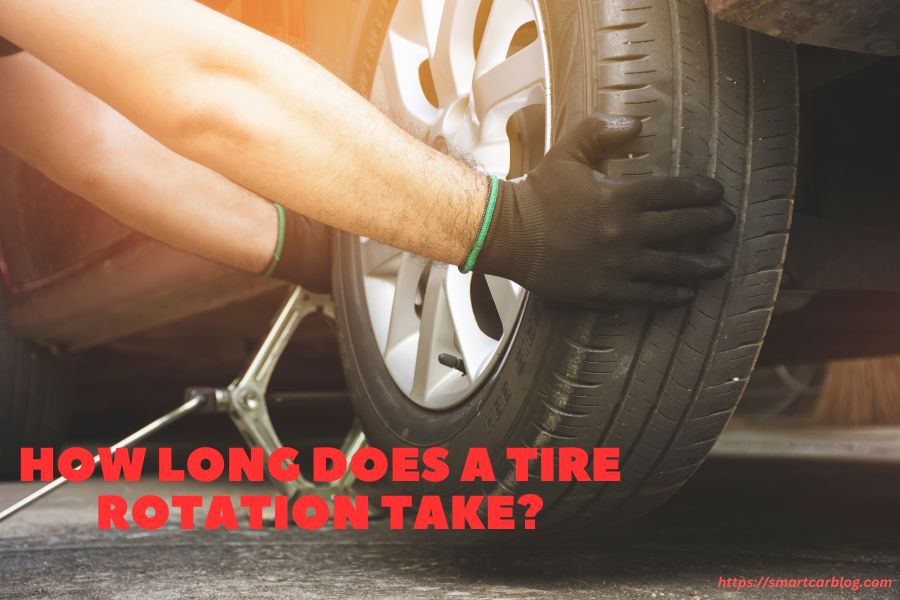The question, “How long does a tire rotation take?” is one that often crosses the minds of vehicle owners aiming to balance the demands of maintenance against their busy schedules. Tire rotation, a fundamental aspect of car care, ensures even tire wear, prolonging the life of the tires and enhancing overall vehicle performance. However, understanding the time commitment involved is crucial for individuals planning their maintenance routines effectively.
In this comprehensive guide, we explore the intricacies of tire rotation duration. Exploring factors such as vehicle type, rotation patterns, and the impact of professional services versus DIY methods, we aim to demystify the process. By unraveling the complexities surrounding tire rotation time, this guide equips readers with valuable insights, enabling them to make informed decisions about their vehicle maintenance. Let’s embark on this journey to uncover the time investment necessary for one of the most critical aspects of car care.
Table of Contents
ToggleUnderstanding Tire Rotation Basics
In the sphere of vehicle maintenance, tire rotation plays a crucial role that’s often overlooked. For the uninitiated, tire rotation might sound like a complex task involving tires spinning on their axis. However, it refers to the practice of periodically moving the tires from one position on the vehicle to another to ensure even tread wear and extend the lifespan of your tires.
What is Tire Rotation?
Tire rotation involves changing the positions of your vehicle’s tires at regular intervals. This process ensures each tire serves in as many of the vehicle’s wheel positions as possible to promote uniform wear. The specific pattern of tire rotation can vary depending on measures such as the type of vehicle (front-wheel drive, rear-wheel drive, all-wheel drive), the type of tires (directional, non-directional), and the manufacturer’s recommendations.
For instance, in a simple front-to-rear rotation for a rear-wheel-drive vehicle, the front tires are moved to the rear axle, and the rear tires are moved to the front axle. In a more complex rotation pattern, such as the X-pattern, the front and rear tires are moved diagonally.
It’s worth noting that the recommended rotation interval can vary. However, a good rule of thumb is to rotate your tires every 6000 to 8000 miles(9,600 to 12,800 kilometres) or as suggested by your vehicle’s manufacturer.
Remember, while tire rotation might seem like a simple task, it involves lifting the vehicle and removing all tires, which requires the right tools and knowledge. If you need more time to do it yourself, consider scheduling an appointment with a professional service centre.
The Importance of Tire Rotation
Tire rotation is an imperative part of vehicle maintenance for a variety of reasons. Primarily, it helps to balance the tread wear on all four tires, promoting even wear and prolonging the tire’s life. Uneven tire wear can lead to impecunious performance, reduced fuel efficiency, and even safety issues such as blowouts. By rotating your tires regularly, you can eliminate these problems and keep your vehicle running smoothly.
Moreover, tire rotation can provide an opportunity to inspect the tires for damage, check tire pressure, and rebalance the tires as needed. Regular rotation can help identify issues in the early stages before they become serious (and potentially costly) problems.
The Process of Tire Rotation
The process of tire rotation isn’t just about swapping the tires. It involves a detailed checkup and adjustment, which can take patches from 15 to 45 minutes, depending on the type of vehicle and the service centre’s efficiency.
Pre-Rotation Inspection
Before the actual rotation process begins, a trained mechanic will perform a thorough examination of your tires. They will check for uneven wear patterns, punctures, or any other damage that could potentially cause issues down the line.
They’ll also look at tire pressure, as incorrect pressure can lead to faster wear and tear. All these checks ensure that your tires are in good condition to be rotated. This pre-rotation inspection typically takes around 5-10 minutes.
The Actual Rotation
The actual process of rotating the tires comes next. This involves removing each tire and swapping their positions. The pattern of this swap depends on various factors like the type of drive (front-wheel, rear-wheel, all-wheel), the type of tires, and whether or not you have a full-size spare tire.
Generally, for front-wheel-drive vehicles, the front tires move straight back to the rear, and the rear tires move to the front but swap sides. For rear-wheel-drive or four-wheel-drive vehicles, the rear tires move straight to the front, and the front tires move to the rear but swap sides.
This process can take around 10-20 minutes, depending on how quickly the mechanic works.
Post-Rotation Checkup
Once the tires have been rotated, another inspection is performed. The mechanic will check to see if the tires are seated properly and then adjust the tire pressure as needed. They’ll also take the time to reset your vehicle’s Tire Pressure Monitoring System (TPMS) if it has one.
The post-rotation checkup generally takes about 5-10 minutes, rounding up the total time for a tire rotation to approximately 15-45 minutes.
Remember, regular tire rotations can help you avoid costly repairs in the future and improve your vehicle’s performance. So, while it may take a bit of time, it’s definitely worth the investment.
How Long Does a Tire Rotation Take?
Tire rotation is a standard vehicle maintenance procedure that ensures even tire wear, optimal performance, and safety on the road. Car owners often wonder about the time it takes to perform a tire rotation, considering the impact it has on their daily schedules and plans. Let’s delve into the specifics of the time involved in this essential maintenance task.
Average Duration of a Tire Rotation
The average duration of a tire rotation typically ranges from 20 to 45 minutes. However, it’s important to note that this timeframe can vary based on several factors. Professional mechanics experienced in tire rotations can efficiently complete the process within this time frame. During this time, the vehicle is lifted, the wheels are removed, rotated as per the appropriate pattern, and then reinstalled. The process might take a bit longer if additional services, such as wheel balancing or alignment checks, are performed simultaneously.
Factors that Influence the Time Taken for Tire Rotation
Several factors influence the time taken for a tire rotation, including:
⇒ Type of Vehicle: Larger vehicles, such as SUVs and trucks, often have larger and heavier tires, requiring more effort and time to handle during rotation.
⇒ Number of Tires: Obviously, the more tires there are to rotate, the longer the process will take. Standard vehicles have four tires, but some vehicles, like trucks, might have dual rear tires, adding to the complexity and time.
⇒ Experience of the Mechanic: A skilled and experienced mechanic can perform a tire rotation more quickly and efficiently than someone with limited experience. Their expertise allows for a smoother process, reducing the overall time taken.
⇒ Additional Services: If the mechanic identifies issues such as unbalanced wheels or misalignment while rotating the tires, additional services might be required. Addressing these issues simultaneously can extend the time taken for the entire maintenance procedure.
Understanding these factors helps car owners anticipate the time required for a tire rotation. Regular tire rotations, despite the time involved, are invaluable in ensuring the longevity of your tires, maintaining optimal vehicle performance, and ensuring safety on the road.
The Efficiency of Professional Tire Rotation
Ensuring our vehicles are running efficiently often hinges on minor maintenance tasks that, when overlooked, can lead to major issues. Among these tasks, tire rotation stands out as both crucial and frequently underestimated. The effectiveness of this process can significantly vary based on who handles the task. This leads us to the question: what makes professional tire rotation so efficient?
Why Choose Professionals for Tire Rotation?
✔ Expertise & Experience: Professionals possess the required know-how derived from years of training and experience. This expertise ensures that the tire rotation is done correctly, maximizing the lifespan of your tires and ensuring optimal vehicle performance.
✔ Advanced Equipment: Professional service centres are equipped with state-of-the-art machinery that not only ensures precision but also minimizes the risk of any potential damage during the process.
✔ Safety: Tires play a pivotal role in vehicle safety. Professionals guarantee that the tires are not just rotated but also checked for any issues that might compromise safety, such as uneven wear or punctures.
✔ Warranty Preservation: Many tire manufacturers require regular rotations as part of the warranty conditions. Professionals provide documentation of service, ensuring your warranty remains intact.
Time Management in Professional Tire Rotation Services
Efficiency isn’t just about the quality of work but also the time taken to accomplish it. Here’s why professionals excel in managing time during tire rotation:
Streamlined Processes: With established procedures in place, professionals can rotate tires systematically, reducing the chances of oversight and redundancy.
Skilled Technicians: Their familiarity with diverse vehicle models ensures quick identification of rotation patterns, saving time during the process.
Multiple Services: Often, while your tires are being rotated, professionals can simultaneously check for other potential issues, thus maximizing the utility of your visit.
Scheduled Appointments: Professional service centres usually work on appointments, ensuring you save time waiting in line. You’re in, out, and back on the road swiftly.
In essence, while one might consider performing tire rotation independently, the efficiency and assurance offered by professionals are unmatched. Not only do they bring technical expertise to the table, but their approach to time management also exemplifies the adage: time is money. So, the next time you’re contemplating the efficiency of a professional tire rotation, remember that it’s a blend of quality work and timely service.
DIY Tire Rotation: Is It Worth It?
The prospect of saving money often leads car owners to consider do-it-yourself (DIY) tire rotation. But is the cost-saving worth the time and effort involved? Let’s explore the steps involved in DIY tire rotation and evaluate the time consumption to understand if it’s a practical choice for vehicle maintenance.
Steps to DIY Tire Rotation
Performing a DIY tire rotation involves several steps:
Gather Necessary Tools: Collect tools such as a jack, jack stands, lug wrench, and torque wrench. Ensuring you have the right equipment is essential for a safe and efficient tire rotation.
Lift the Vehicle: Use the jack to lift the vehicle off the ground, ensuring it is stable and secure with jack stands.
Remove and Inspect Tires: Take off each tire and inspect them, for example, wear and tear. This step is crucial for identifying any underlying issues with your tires.
Rotate Tires: Follow the appropriate rotation pattern (cross, forward, rearward) based on your vehicle type. Each pattern serves a specific purpose, ensuring even wear on all tires.
Reinstall Tires: Put the tires back on the vehicle, tightening the lug nuts securely with a torque wrench to the manufacturer’s specifications.
Lower the Vehicle: Carefully lower the vehicle back to the ground using the jack, ensuring all tires are making full contact with the surface.
Time Consumption in DIY Tire Rotation
DIY tire rotation, while cost-effective, can be time-consuming:
Preparation Time: Gathering tools, reading guidelines, and ensuring a safe working environment takes time, especially for those new to the process.
Execution Time: The actual tire rotation process demands precision and care. If you’re not experienced, it might take longer to perform the rotation correctly.
Inspection Time: Thoroughly inspecting each tire for wear patterns, damages, and inflation issues adds to the overall time.
Learning Curve: For beginners, there’s a learning curve involved in understanding rotation patterns and ensuring they are implemented correctly.
While DIY tire rotation offers potential savings, it requires an important investment of time and effort. Additionally, improper rotation can lead to uneven tire wear, affecting vehicle performance and safety. Considering these factors, individuals should weigh the cost savings against the time and expertise required, deciding if it’s a worthwhile venture for their specific situation.
The Impact of Tire Rotation on Vehicle Performance
Tire rotation plays a significant role in enhancing various aspects of a vehicle’s performance. Understanding how it affects fuel efficiency and vehicle balance provides valuable insights into the importance of this routine maintenance task.
Tire Rotation and Fuel Efficiency
Properly rotated tires contribute to improved fuel efficiency. Unevenly worn tires can increase rolling resistance, making the engine work harder to move the vehicle. By ensuring even tire wear through regular rotation, the tires maintain consistent contact with the road. This consistency reduces resistance, allowing the vehicle to move more smoothly, thereby enhancing fuel efficiency. Over time, the fuel savings accrued from efficient tire rotation can be substantial, making it a cost-effective practice for any vehicle owner.
Tire Rotation and Vehicle Balance
Balanced tires are crucial for a stable and smooth ride. When tires wear unevenly due to factors like misalignment or improper inflation, the balance of the vehicle is compromised. This imbalance can lead to vibrations and handling issues, making driving less safe and comfortable. Regular tire rotation helps in equalizing tire wear, promoting balanced performance. When all tires wear uniformly, the vehicle maintains its stability, ensuring a safer driving experience. Additionally, balanced tires contribute to extended tire life, reducing the frequency of replacements and saving costs in the long run.
Understanding the relationship between tire rotation, fuel efficiency, and vehicle balance emphasizes the importance of this maintenance practice. By ensuring even tire wear and balanced performance, tire rotation not only enhances fuel economy but also guarantees a safer, smoother, and more enjoyable driving experience for car owners. Regularly rotating tires is a small investment that yields significant dividends in terms of both performance and savings.
Must Read: How Long Does a Car Inspection Take? A Comprehensive Guide
Must Read: Why Does My Car Shake When I Brake? You Need To Know Everything!
Regular Tire Rotation: A Key to Longevity
For any vehicle enthusiast or even the average car owner, ensuring the longevity of a vehicle is paramount. We often think about engine care, frequent oil changes, and regular servicing. However, tucked within these broader maintenance categories is the subtle yet essential practice of tire rotation. Regular tire rotation isn’t just a suggestion—it’s a vital step to prolong the life of your tires and, by extension, enhance your vehicle’s performance. But how frequent is “regular”, and what happens if this task slips through the cracks?
How Often Should You Rotate Your Tires?
General Guideline: The consensus among auto experts is that tires should be rotated every 6,000 to 8,000 miles. However, it’s always wise to consult your vehicle’s owner manual, as recommendations can vary based on the make and model.
Driving Conditions: If you frequently drive on rough terrains, gravel roads, or conditions that exert added stress on the tires, consider rotating them more often.
Tire Type: Different tire types—whether all-season, performance, or winter tires—may have varied rotation schedules. Again, checking with the manufacturer or tire specialist can offer tailored advice.
Visual Checks: If you notice uneven wear patterns earlier than your planned rotation interval, it’s a clear sign that your tires need attention. Don’t wait for the mileage milestone—rotate them promptly.
The Consequences of Skipping Tire Rotation
Neglecting regular tire rotation might seem harmless in the short term, but the long-term implications can be substantial:
Uneven Tire Wear: Tires wear at different rates, especially the front set, due to their role in steering and braking. Without rotation, you’ll soon find uneven tread depths, which can compromise traction and safety.
Reduced Tire Lifespan: Uneven wear means some tires will reach their wear limit faster than others. This not only leads to premature replacement but also hampers overall vehicle performance.
Decreased Fuel Efficiency: As mentioned earlier, uneven tires can increase rolling resistance, causing your vehicle to burn more fuel than necessary.
Compromised Safety: Tires with uneven wear can affect your vehicle’s balance, handling, and braking efficiency. This makes it harder to control the car during sudden maneuvers or in adverse conditions, potentially leading to accidents.
In a nutshell, the time it takes to rotate your tires is a minor investment when you weigh it against the benefits. Regular tire rotation doesn’t just ensure even tread wear—it’s key to maintaining optimal vehicle performance, safety, and longevity. Remember, by caring for your tires, you’re not only saving money but also ensuring a safer, smoother journey every time you hit the road.
Final thought
In summary, a tire rotation typically takes between 20 to 45 minutes. Understanding this timeframe is crucial for effective time management.
Whether opting for professional services or DIY, recognizing the investment allows for smoother planning and ensures regular, essential vehicle maintenance. Time spent on tire rotations translates into extended tire lifespan, improved safety, and enhanced driving experiences.
FAQ
FAQ 1: How long does a typical tire rotation take?
Answer: A standard tire rotation usually takes between 20 to 45 minutes, depending on various factors like vehicle type and additional services.
FAQ 2: Does the tire rotation time vary for different vehicles?
Answer: Yes, the time for tire rotation varies based on the vehicle type. Larger vehicles like SUVs or trucks might take a bit longer compared to smaller cars.
FAQ 3: Can I get my tires rotated faster at a professional service centre?
Answer: Yes, experienced mechanics at professional service centres can efficiently rotate your tires, ensuring a swift process without compromising quality.
FAQ 4: How frequently should I rotate my tires?
Answer: It’s recommended to rotate your tires every 6,000 to 8,000 miles or as advised in your vehicle’s manual, ensuring even wear and optimal performance.
FAQ 5: Are there any additional services included in tire rotation?
Answer: Additional services such as wheel balancing or alignment checks might extend the rotation time slightly but contribute to better tire longevity and vehicle stability.
FAQ 6: Can I rotate my tires on my own, and how long would it take for a DIY rotation?
Answer: Yes, you can rotate your tires at home. A DIY tire rotation might take around 20 to 30 minutes if you have the necessary tools and experience.
FAQ 7: Is there a specific rotation pattern that takes less time?
Answer: Rotation patterns like the forward or rearward method can often be quicker compared to complex patterns, ensuring efficient tire rotation.
FAQ 8: How does tire rotation time impact fuel efficiency?
Answer: Even tire wear through rotation reduces rolling resistance, contributing to improved fuel efficiency and saving you money on fuel in the long run.
FAQ 9: What should I do if I don’t have time for regular tire rotations?
Answer: If you’re short on time, consider professional services, ensuring your tires are rotated efficiently, and your vehicle’s performance remains optimal.
FAQ 10: Does tire rotation time vary based on the condition of the tires?
Answer: Yes, severely worn or damaged tires might require additional inspection, potentially extending the rotation time to ensure proper evaluation and safe driving conditions.




 Welcome to SmartCarBlog.com! I’m Rashel Miajee, The proud founder of smartcarblog.com. This is a part of
Welcome to SmartCarBlog.com! I’m Rashel Miajee, The proud founder of smartcarblog.com. This is a part of 


